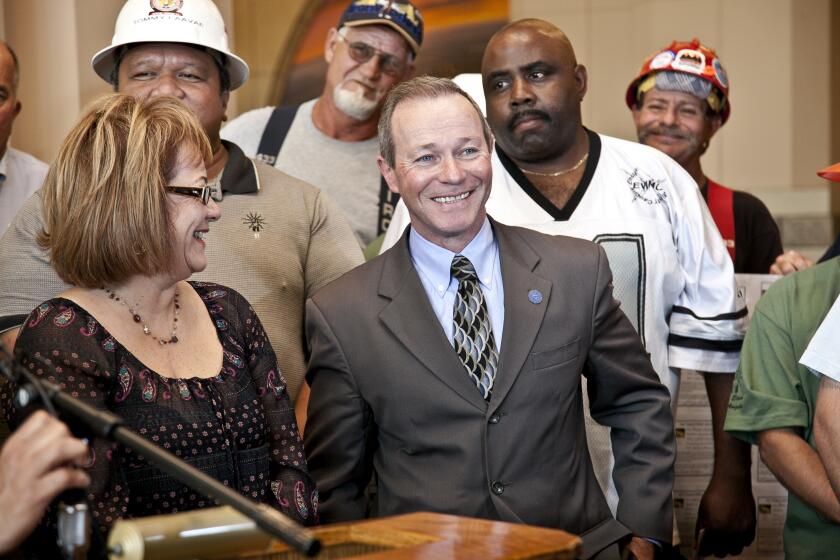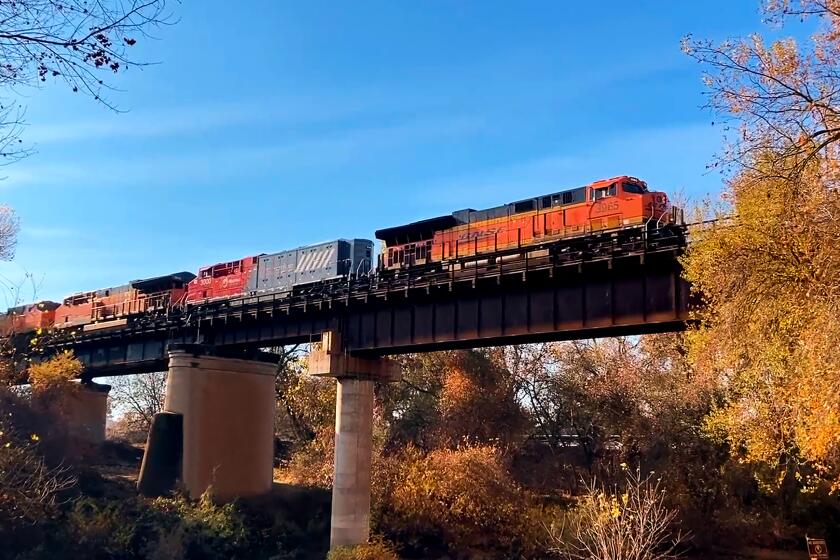Democrats in California and D.C. clash over how state’s high-speed rail should be powered

A key bloc of California lawmakers is feuding with the Biden administration over the state’s high-speed rail endeavor, arguing that conditions of a restored federal grant lock the project into what the group sees as an outdated technology for powering the bullet train.
In a recent letter to U.S. Transportation Secretary Pete Buttigieg, California Speaker Anthony Rendon and 17 other Assembly Democrats say the federal grant unnecessarily directs California to use overhead electrical lines to propel the trains down their tracks.
Instead, Rendon wants California to keep open the option of powering locomotives with batteries or fuel cells, arguing that the switch could help the state avoid the high cost of installing overhead lines, a system used worldwide since the 1960s.
The Rendon letter — sent to Buttigieg late last month — comes amid an increasingly intense standoff between Gov. Gavin Newsom‘s administration and the Assembly leader on design and funding for the nation’s largest single transportation project. Newsom wants California to stick to his plan of building the first segment of the high-speed rail line in the Central Valley, but Rendon and his Assembly allies want to divert the funds to bullet train segments in Southern California and the Bay Area, and fears installation of electric lines will close off that prospect.
In June, the Biden administration reinstated a $929-million Obama-era grant to help construct the San Joaquin Valley high-speed rail line, which President Trump terminated in 2019. California filed a lawsuit against the federal action, which the Biden administration settled last month, resulting in the $929 million being reissued.
But in restoring the grant, the terms were modified to require the state to adopt a wired system. The new federal grant language contains 27 references to electrification of the system in the Central Valley, whereas the original funding agreement only mentioned once that the rail project had to plan for electrification.
The bullet train project is attempting to build a 171-mile operating segment between Bakersfield and Merced for $22.8 billion, which would consume nearly all of the existing funds for the project through 2030. The project is short $80 billion to execute the original vision of a 220-mph train from Los Angeles to San Francisco, which voters approved by passing Proposition 1A in 2008.
Organized labor has provided crucial support for the high-speed rail project, discouraging any straying from California’s current plan.
The changes in the grant would go against the wishes of the electorate, according to the Rendon letter. “By now incorporating the reference to electrification into the settlement agreement, we are changing the terms of what was agreed to by the voters,” the letter said.
A U.S. Department of Transportation spokesperson said in an email that the agency “values” Rendon’s input and will be responding “shortly.”
The email makes clear that electrification in the Central Valley is “included in the [grant agreement] recently executed among the parties.” It adds that the requirement was included in the bond act.
The controversy comes at a key moment in the troubled history of the project. Newsom requested the Legislature appropriate $4.2 billion, the last remaining funds from the $9-billion bond fund voters approved in 2008. Lawmakers passed a budget and adjourned without approving the request.
“Negotiations are ongoing between the Legislature and the Governor’s office on these issues,” said rail authority spokeswoman Annie Parker.
U.S. Sens. Diane Feinstein and Alex Padilla applied further pressure on Rendon and his Assembly allies this week, urging them in a letter to adopt the $4.2-billion budget request and implicitly agree to the electrification plan. “Now is not the time for California to step back from its commitment to high-speed rail, a mode of transportation that is critical to reducing congestion and meeting our critically important climate goals,” the letter said.
Rendon responded with a tweet that indicated he is holding his position: “The Assembly is dedicated to making the initial Central Valley line an actual useable segment that will alleviate the most congestion and greenhouse gases as possible. The existing project has been scaled back from two tracks to one track and will not adequately serve the Central Valley, let alone the rest of the state. I believe we can do better than that.”
A year ago, a majority of Democrats in the Assembly cosponsored a resolution to defer building the partial operating system in the Central Valley — and delay electrification until links are ready to Southern California and the Bay Area. The idea is to allocate some of the money to a Burbank-to-Anaheim high-speed segment and a tunnel under downtown San Francisco. Both of those have long been part of the master plan for the high-speed rail system.
The diverted money would come in part from delaying the installation of the electrical system.
The rail authority had planned to issue a contract next month to cover installation of tracks, signals and the electrical system. The authority said the COVID-19 pandemic has caused delays and it now plans to request proposals in the fall.
Paul Dyson, a longtime passenger rail advocate from Burbank, said installing wires for a partial system in the Central Valley would create an ongoing expense for the state. Crews would have to be trained, maintenance facilities constructed and trainset purchased, all for a lightly used system. “It is going to be fiendishly expensive,” he said.
But the Rail Passenger Assn. of California and Nevada, an advocate for high-speed rail, wrote its own letter to Buttigieg to support the plan for wires. “Overhead electrification has proven reliable and is safe and cost effective for high-speed rail systems around the world,” it said.
Brian Kelly, chief executive of the California High-Speed Rail Authority, has opposed any delay in installing a power system in the Central Valley, arguing that completion of an operating high-speed segment between Bakersfield and Merced is essential to demonstrating the benefits of the concept and will spur support to complete a statewide system.
The rail authority also asserts that the bond act requires electrification, since it is the only way the system can achieve the high speeds mandated by the law.
The rail industry is testing trains powered by fuel cells and lithium batteries. But it is resisting a switch from diesel locomotives due to costs.
But the lawmakers are not retreating.
The June 29 letter to Buttigieg, which also was signed by Transportation Committee Chairwoman Laura Friedman (D-Glendale), asserts that the state could tap into rapidly evolving technology of fuel cell and battery-operated trains, which are already operating to a limited extent in Europe. San Bernardino County transportation officials recently ordered a hydrogen fuel cell train to operate on a future Metrolink route to Redlands.
Rendon and Friedman, along with other lawmakers, say diverting some of the money from the Central Valley and investing it in bullet train segments in Los Angeles and Orange County would create greater ridership much sooner than sinking money into electrifying the Central Valley.
The impasse reflects growing frustration in the Legislature with the project’s cost growth and setbacks since the first construction contract was issued in 2013.
More to Read
Start your day right
Sign up for Essential California for news, features and recommendations from the L.A. Times and beyond in your inbox six days a week.
You may occasionally receive promotional content from the Los Angeles Times.









